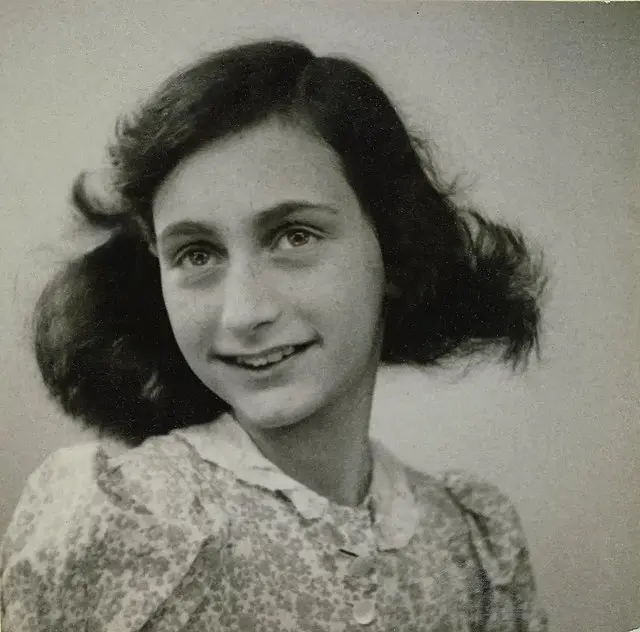
Introduction
Who is Anne Frank?
Born on June 12, 1929, Annelies Marie ‘Anne’ Frank was a German-Jewish teenager who gained posthumous fame for her candid diary entries written during World War II. Her sudden musings showcased her experiences and emotional journey while hiding with her family during the Nazi era. Hidden behind a bookcase in a secret annex in Amsterdam, they lived in constant fear of being discovered. The Diary of Anne Frank paints an intimate picture of her life and thoughts, serving as a poignant symbol of the innocent lives destroyed by the Holocaust. Despite her tragic end in Bergen-Belsen concentration camp, Anne Frank’s inspiring words live on and continue to touch hearts.
Brief Overview of the Blog Content
This intriguing piece provides a deep-dive exploration into the world of Anne Frank, an emblematic figure from the Holocaust whose diary has touched millions worldwide. Explore little-known details of Anne’s life, including her family background, heartbreaking experiences, and the legacy she left behind. Each fact about this remarkable girl adds to our understanding of her courage, resilience, and indomitable spirit during some of history’s darkest hours. From surprising personal hobbies to her profound global impact, the upcoming insights are intended to enlighten and engage readers, offering a fresh perspective on this iconic figure.
Understanding Anne Frank’s Early Years
Birth and Family Background
Born on June 12, 1929, in Frankfurt, Germany, Annelies Marie Frank, more commonly known as Anne Frank, emerged from a liberal Jewish background. Her father, Otto Frank, was a decorated Army officer in World War I, and he later became a successful businessman. Her mother, Edith Holländer Frank, originated from a prosperous German-Jewish family. Anne also had an older sister, Margot. The Franks were a typical upper-middle-class German-Jewish family living in a peaceful, religiously diverse neighborhood. However, the racial and political tensions that escalated into Nazi supremacy in Germany in the 1930s radically disrupted their harmonious family life.
Early Education and Personality Traits
Born in Germany in 1929, Anne was a bright and inquisitive child from the start. At her Montessori nursery in Amsterdam, where her family relocated, she was popular, curious, and playful, easily attracting friends due to her vibrant personality. Despite living in turbulent times, it was here that Anne’s love for reading and writing blossomed. One can discern that she was a natural communicator, possessed with a determined spirit, from the profound thoughts she expressed in her world-renowned diary. These are traits that would later help her cope with the harsh reality of life in hiding during the Holocaust.
Life during the Second World War
Impact of Nazi Invasion on Anne’s Life
The chilling ripples of the Nazi invasion gravely impacted Anne’s previously normal life. As religious persecution intensified, Otto Frank, Anne’s father, moved the family into a secret annex within his business premises, where they clandestinely spent over two years. During this period, the normal rhythm of Anne’s teenage life was entirely usurped by fear, insecurity, and confinement. Her schooling halted abruptly, and any semblance of social life disappeared. Anne’s only solace was her diary, where she chronicled her experiences with uncommon sensitivity and insight. Survival became their primary focus; they had to remain completely silent during the day to avoid detection. Though Anne attempted to maintain a semblance of normalcy by studying and writing, the constant threat of betrayal or discovery loomed large.
Life in the Secret Annex
Despite the burgeoning chaos of WWII, Anne Frank and her family managed to carve out an existence in a hidden attic compartment, famously known as the ‘Secret Annex’, in her father’s business premises in Amsterdam. Forced to confine themselves in this cramped space from 1942 to 1944, they lived in constant fear of detection by the Nazis. With minimal daylight and living under a strict protocol of silence, their everyday reality was marked by tension, looking out for any suspicious noise that would indicate their discovery. The documented accounts of their struggle for survival show how Anne’s vitality and optimistic spirit were undimmed, even in these desolate circumstances. Murky as life seemed, the annex’s residents found little ways to maintain hope, always hoping for an end to their prolonged humiliation.
The Famous Diary of Anne Frank
The Diary as an Outlet for Anne’s Thoughts and Feelings
In the midst of fear, uncertainty, and confinement, a young Jewish girl named Anne Frank found solace in her cherished diary, which later became an enduring symbol of the human spirit under oppression. During her two years in hiding during World War II, this diary served as her faithful confidante, a safe haven for her deepest thoughts, hopes, fears, and revelations. Anne used it to articulate her views about the situation around her, about life, her dreams, and her personal growth. She did not shy away from sharing her conflicts as well as the spark of hope and humor that kept her sane. The raw and poignant accounts written in this diary provide us with a unique and moving insight into the tragic circumstances of a 15-year-old under Nazi persecution. This diary, a testament to Anne’s resilience and undying hope, is a powerful reminder of the horrors of war as seen through the eyes of a young girl.
Unique Elements of Anne’s Writing
Anne’s expressive and heartfelt insights were captured in an old, red-checked diary, a 13th birthday gift from her father. This poignant memoir became an emblem for Holocaust victims with its impactful narrative detailing a young girl’s experience in hiding during the Nazi regime. Her writing, often tipped with dark humor and an ever-optimistic worldview, grips the reader, making you forget that it was penned by a teenager. The candidness of her emotions, her dreams, her fears, and her nascent awareness of her identity and sensuality captivate the reader. One remarkable feature is her adept use of pseudonyms for real individuals, a depiction of her creative instincts. She explained the darkest realities with simplistic beauty, offering a voice of resilience in despair. Anne’s narration, brimming with vivid detail and adolescent wisdom, transforms her diary from a simple war document into a deeply human record.
Arrest and Later Life
The Betrayal and Arrest
In August 1944, Anne Frank’s two-year-long hideout was tragically breached. An anonymous tip-off to the Nazis led to the discovery of the secret annex, located at the back of Otto Frank’s office in Amsterdam. The Franks, along with four other Jewish fugitives, were arrested and subsequently deported. Anne and her sister Margot were transferred from Auschwitz to the Bergen-Belsen concentration camp, where they both succumbed to typhus in March 1945. The identity of the informant remains a mystery. Otto Frank, Anne’s father, was the only member of the group in the secret annex who survived the Holocaust.
Life in Concentration Camps
Following their arrest in August 1944, Anne and her sister, Margot, were transported to Auschwitz-Birkenau, where life was brutal and fraught with daily struggles. Enduring harsh conditions, the sisters were forced to perform strenuous labor, suffered from malnutrition, and faced the constant terror of death. A few months later, they were transferred to Bergen-Belsen. It was here, amidst dirt, disease, and despair, that they both lost their lives in early 1945, just a few weeks before the camp’s liberation. Their experiences represent the cruelty of life in concentration camps experienced by millions of Jews during WWII.
Legacy of Anne Frank
Publication of the Diary
In 1944, Anne was inspired by a radio broadcast to compose a book based on her diary entries. Two years after her death in the Bergen-Belsen concentration camp, her father, Otto Frank, the sole survivor of the family, fulfilled her wish. He published the book in Dutch in 1947 under the title ‘Het Achterhuis’, meaning ‘The Secret Annex’. The English version, ‘Anne Frank: The Diary of a Young Girl’, was released in 1952. The diary, candid and profound, provides a personal view of Holocaust horrors. It has been translated into 70 languages, highlighting Anne’s enduring impact and legacy globally.
Impact and Influence of Anne’s Story
Anne Frank’s Diary offers an intimate, personal perspective of life during one of history’s bleakest times, offering a powerful narrative of hope, resilience, and human spirit that transcends cultural, geographic, and generational boundaries. Her chronicle of hiding from the Nazis, living in fear of discovery, and enduring the trials of adolescence in extreme circumstances profoundly touches all who read it. Not only has her diary been translated into over 70 languages, but it has also influenced countless books, films, and plays, profoundly shaping our understandings of the Holocaust. Through her narratives, she continues to inspire and educate people about tolerance and human rights.
Some less-known Facts about Anne Frank
Unpublished Writings
Despite the popularity of her diary, several of Anne Frank’s writings remain relatively unknown. In addition to her renowned diary, she penned short stories, quotes, and started a novel during her years in hiding. These works offer further insights into her vivid imagination and rich inner life. Unfortunately, several of these pieces were not included in the original publication of her diary, remaining largely undiscovered and unpublished until recent years, revealing a truly gifted young author.
Impact on Pop Culture and References
Anne Frank’s diary has had a significant influence on popular culture, inspiring numerous works globally. Various movies, plays, and books pay homage to her life and tragic experiences. For instance, “The Diary of Anne Frank” won a Pulitzer Prize. Her story can be found echoed in song lyrics like “One Tin Soldier” by The Original Caste and narratives such as “The Freedom Writers Diary.”. Even iconic sitcoms like ‘The Simpsons’ have recognized her impact through episodes spotlighting her diary.
Conclusion
Final Thoughts and Reflections
In summation, Anne Frank’s inspiring life and courageous spirit have left an indelible mark on human history. Her diary serves not just as a window into the harrowing experiences of a teenage girl during the Holocaust but also testifies to her enduring resilience and hope. It highlights her belief in the innate goodness of humanity, even in the midst of unprecedented atrocities. Anne’s thoughts and philosophies continue to inspire and educate millions worldwide, reminding us of the importance of unity, tolerance, and the will to overcome adversity. Her story illustrates the power of the human spirit to survive and endure.



